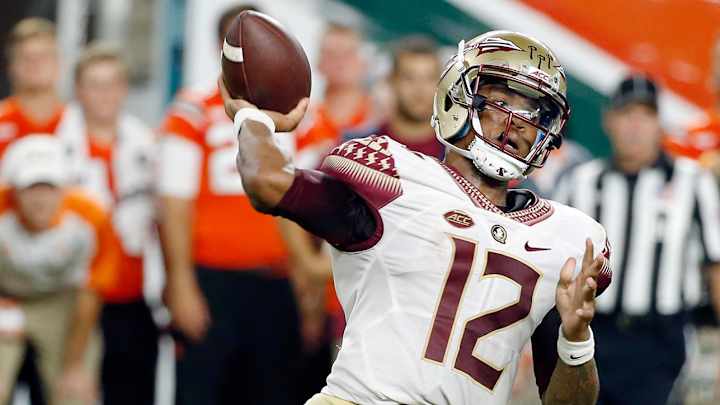Florida State QB Deondre Francois shines as Seminoles edge Miami in rivalry game

It seemed almost too simple. No. 10 Miami controlled the first half. No. 23 Florida State controlled the second half. The Seminoles capitalized on more of their opportunities, so they’d win.
Then Braxton Berrios showed off some track speed to return a punt 43 yards, setting up Miami on the Florida State 16 with 5:42 to play down 20–13. The Hurricanes capitalized on the short field as quarterback Brad Kaaya lobbed a pass that fell perfectly into the hand of receiver Stacy Coley for an 11-yard score. All Miami needed was to kick the extra point to force overtime, and with a kicker who had made 72 straight extra points, that was a given, right?
DeMarcus Walker, or more specifically his left hand, said no. Walker’s blocked extra point preserved Florida State’s lead and allowed the Seminoles to hang on for a 20–19 victory, their seventh straight over the Hurricanes.
Here are three thoughts on Florida State’s win:
1. Deondre Francois is tough
Florida State’s redshirt freshman came down hard on his right shoulder at the end of the first quarter. He missed the rest of the drive and the Seminoles’ next before returning to the game. Later, he got sandwiched on a late hit while connecting with running back Dalvin Cook for a 59-yard score and again went to Florida State’s sideline medical tent.
But Miami couldn’t keep Francois out of the game. Despite clearly playing through pain, Francois kept slinging passes to help the Seminoles pull out of a 13–0 hole. Coach Jimbo Fisher kept most of Francois’s looks short to prevent the injured quarterback from having to chuck the ball deep downfield, but Francois’s toughness to fight through the pain and keep Florida State’s offense moving was still impressive.
He finished 20 of 31 for 234 yards with two touchdowns and rushed for 21 more yards.
2. The game turned when Florida State's defensive line started winning battles and Miami's stopped
The Hurricanes entered halftime as the clearly superior team. The biggest takeaway midway through the game was questioning why Miami wasn't ahead by more than 13-3.
After a first half marked by some productive drives that ended in field goals, the second half began with more wasted opportunities for the Hurricanes. On their opening drive of the third quarter, Kaaya marched the Canes into the red zone only to make a baffling decision that led to an easy interception for Florida State's Tarvarus McFadden in the end zone.
After that interception, though, the game flipped due to a shift in the battle in the trenches. Miami's defensive line, which had consistently gotten pressure on Francois and limited Cook, lost its edge. The Florida State offensive line got more push, and Fisher used a mix of misdirections and play-actions to keep the defense on its heels.
The result was a Seminoles offense that converted four straight third downs while scoring on consecutive possessions to take the lead. Cook finished with 150 yards on the ground in addition to his 59-yard touchdown catch.
On the other side of the ball, Florida State found similar success as its defensive line began to fluster Kaaya. In the stretch between Kaaya’s end-zone interception and his touchdown pass to Coley, the Hurricanes’ drives ended after they failed to convert on third-and-eight, third-and-15 and third-and-17. Overall Florida State sacked Kaaya three times and held Miami to 62 rushing yards on 2.2 yards per carry. The extra pressure helped the Seminoles’ much maligned pass defense, which entered Saturday 125th in the nation at 9.4 yards allowed per attempt, hold Kaaya to 4.5 yards per attempt.
3. Once again, the ACC Coastal is up for grabs
In past seasons, this was true because no team looked particularly strong, so just about any team in the Coastal seemed capable of beating any other. That’s no longer case, as the quality of the division has clearly improved. But picking a favorite hasn’t gotten much easier.
Miami would have seemed the likely candidate had the Hurricanes prevailed on Saturday. At 2–0 in conference play and with a top-10 ranking, they certainly would have been the team to beat. Instead, Virginia Tech sits atop the standings at 2–0, but the Hokies still have some proving to do after their weather-aided win over North Carolina. Trouncing the Tar Heels 34–3 on Saturday was nice, but an Oct. 20 showdown with Miami in what has to be better conditions will tell us more.

Colin Becht is a college football producer for SI.com and CampusRush.com and has covered college football since 2013.